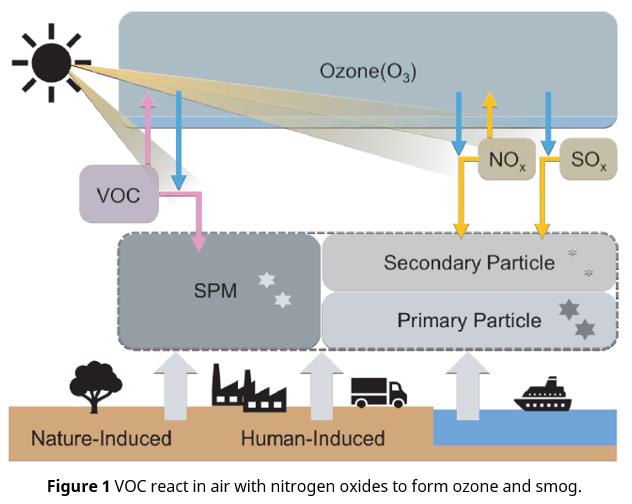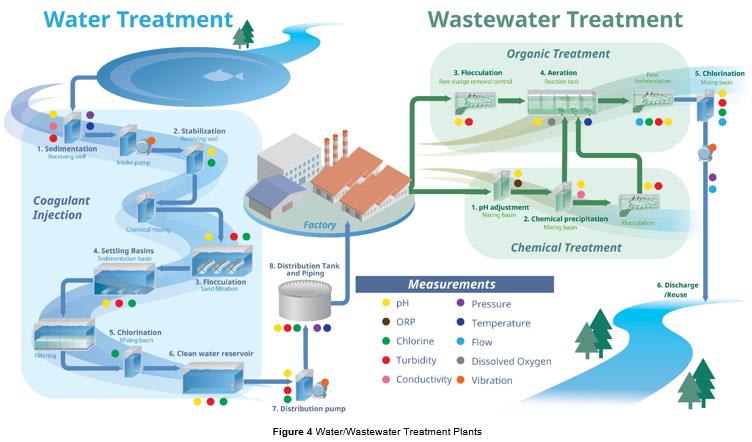Volatile Organic Compounds (VOC) are compounds that evaporate easily at room temperature. They generate photochemical oxidants and cause soil and water pollution.
 Reducing VOC emissions is important to achieve sustainable development goals (SDG), high-quality gas monitoring results in environmental restoration, labor savings, and the improvement of manufacturing plants’ reliability. This application note introduces VOC measurement in flue gas, wastewater, and water purification facilities.
Reducing VOC emissions is important to achieve sustainable development goals (SDG), high-quality gas monitoring results in environmental restoration, labor savings, and the improvement of manufacturing plants’ reliability. This application note introduces VOC measurement in flue gas, wastewater, and water purification facilities.
Some companies have made VOC regulations one of the guidelines for the SDGs since monitoring VOC in water is essential for a sustainable human society and access to clean water.
VOCs such as toluene, xylene, and trichloroethylene are important for industries. Unfortunately, they also affect the human body through the respiratory system, creating health hazards such as headaches and nausea. In addition, VOC contaminates soil and water, causing strange odors and photochemical smog. VOC treatment is an important means to resolving these problems. By using VOC measurement, one can check the removal performance of VOC treatment facilities and whether they conform to emission standards. Primary analytical methods include liquid chromatography, gas chromatography, mass spectrometry, and NDIR (Non-Dispersive Infrared). When measuring the removal efficiency of VOC treatment facilities, VOC concentrations need to be measured at both the inlet and outlet.
GC for VOC Measurement
Yokogawa GC8000 has two applications for VOC measurement. The first is for flue gas and the second is for water.
VOC in Flue Gas
The measurement of VOC in flue gas has been proven mainly in China. Thermal Incineration is a widely used process/technique for VOC removal in China. See Figures 2 and 3 for the RTO (Regenerative Thermal Oxidizer) Process and VOC system graphic.

The sample is taken out by the probe with the heating and back purge function, transmitted to the SCS (Sample Conditioning System) by the heat trace bundles, pressurized and filtered, and then measured by the GC8000. The flue gas temperature, pressure, and flow rate must also be measured to obtain stable quantitative results. The signal is transmitted to the DAS (Data Acquisition System), and the signal is divided into multiple channels through the signal distributor in the DAS.
One channel enters the DAS computer for calculation and storage, and the result is communicated to the DCS (Distributed Control System). The other channel enters the wireless digital acquisition instrument for calculation. Then the GPRS (General Packet Radio Service) signal is transmitted to the EPA (Environmental Protection Agency) data platform.
VOC in Water
The measurement of VOC in water is successfully demonstrated in water purification facilities and wastewater facilities. See Figure 4 for the Water/Wastewater treatment plants graphic.

Yokogawa’s GC8000 can measure more than 20 species of VOC, and some components can be measured in the parts per billion concentration levels in purified water. This system requires a unique sampling system design and regular maintenance to perform the stable measurement. Though sometimes challenging to handle, the frequency of care can be significantly reduced depending on all the preparations (including specification, understanding of process information, etc.). Figure 5 shows the system diagram.
The sample is pumped from raw water (waste or pure) and passes through a filtration system in which large-grain particles (impurities) are removed. Then VOC is extracted from the sample by bubbling N2 gas in a heated sparger and transmitting it to the GC8000. A small amount of sample gas is collected by a sampling valve, pushed by a carrier gas (N2), and introduced into a separation column, where the FID detects each VOC component.

Figure 6 shows a principal diagram of a continuous VOC extraction tank, called a sparger. VOC components are obtained by bubbling N2 gas in the constant-temperature water tank with continuously flowing sample water. When the temperature in the sparging tank of the sample water and the gas flow rate is kept constant, a stable VOC extraction rate is obtained. In other words, this sampling conditioning system enables continuous measurement of VOC in water corresponding to quantitative measurement.

The sampling method using a sparger is an example of the “dynamic headspace method.” There is another dynamic headspace method called the “thin-film headspace method,” used in industry-leading chemical manufacturing.

Table 1 below shows a summary of GC8000 applications in flue gas and water.

Key Benefits
 In the Yokogawa analyzer portfolio, the GC1000 Mark II was subsequently replaced by the GC8000.
In the Yokogawa analyzer portfolio, the GC1000 Mark II was subsequently replaced by the GC8000.
- Intuitive touchscreen HMI
- Intuitive HMI allows for easy navigation from screen to screen
- User friendly display makes interpreting process data quick and easy
- Multiple ovens and gas chromatograph module (GCM)
- Parallel chromatography reduces cycle times
- High-sensitivity thermal conductivity detectors (TCDs)
- Fewer measurements require FID’s and FPD’s
- Reduces maintenance and operational costs
- Floating valve seats
- Extends life to over 1 million cycles
- Easily maintained and replaced
- Pressure regulators mounted in oven
- Electronic pressure compensation is not required
- Reduces cost and overall analyzer complexity
Industries
-
Drinking Water Treatment
The goal of drinking water treatment is to produce clean, safe, and potable water that meets regulatory standards and is suitable for drinking and other domestic uses.
-
Oil & Gas Downstream
The oil & gas downstream industry has been facing an increasing number of challenges in recent years. These include the changing characteristics of the feedstock to be processed, aging of process facilities and equipment, rising cost of energy, lack of skilled plant operators who can run a refinery safely and efficiently, and the ever-changing requirements from both the market and the customer.
Over the years, Yokogawa has partnered with many downstream companies to provide industrial solutions focused on solving these challenges and problems. Yokogawa's VigilantPlant solutions have helped plant owners to achieve maximum profitability and sustainable safety within their plants.
-
Refining
In the ever-changing marketplace, refineries are seen not only as crude processing units but also as profit centers. At the same time, there is a keen awareness of the need for safety at such facilities. A total production solution that encompasses planning, scheduling, management, and control is required to achieve long-term goals for profitability, efficiency, and environmental protection. With years of expertise in the automation field, Yokogawa can bring you affordable total solutions for improved operability and a cleaner world.
Related Products & Solutions
-
Process Gas Chromatograph GC8000
The GC8000 has a built-in 12-inch color touchscreen display that dramatically simplifies operations. At the touch of the screen, the technician can access all of the analytical parameters and measurement results; displayed in easy-to-understand graphical color screens.
-
Gas Analyzers
- Gas analyzers
- Real-time gas analysis
- Enhances efficiency, safety, throughput, product quality
- Ensures environmental compliance
-
Process Gas Chromatographs
- Process gas chromatography machines
- For separating and analyzing chemical compounds in gas phase of online industrial processes
Have Questions?
Contact a Yokogawa Expert to learn how we can help you solve your challenges.